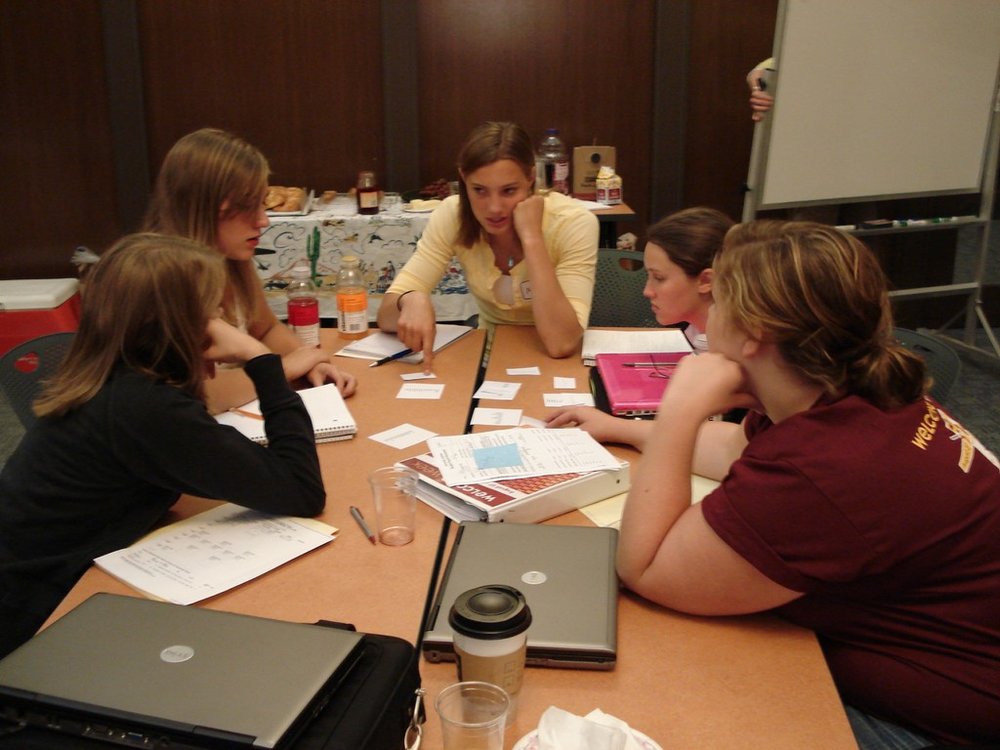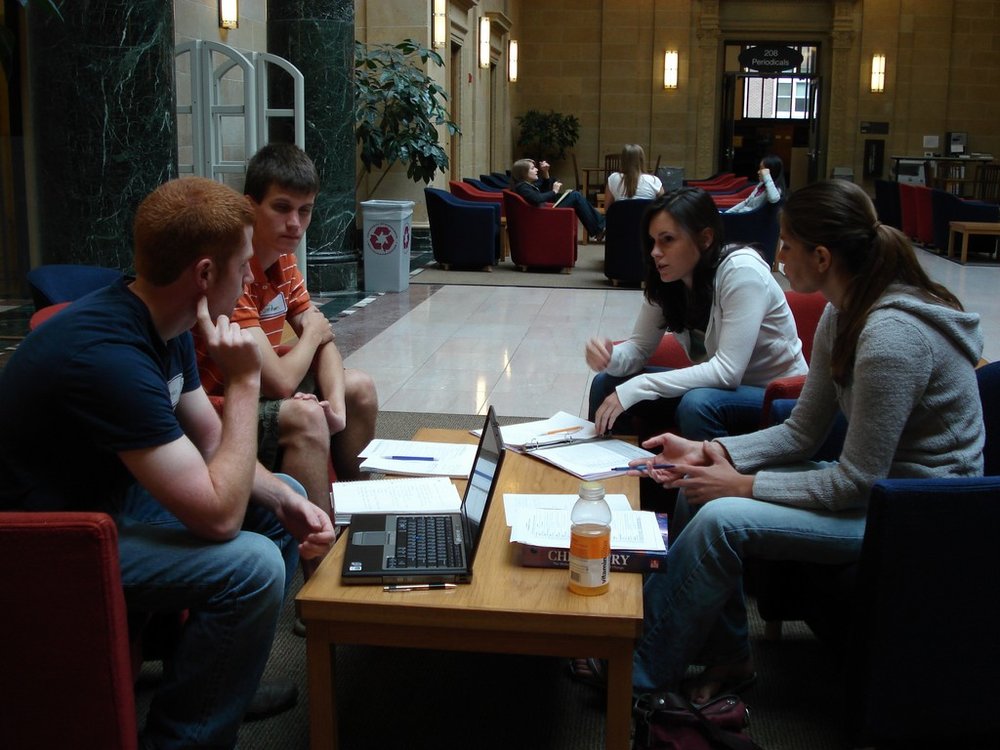
This blog focuses on my scholarship in my five research projects: learning assistance and equity programs, student peer study group programs, learning technologies, Universal Design for Learning, and history simulations. And occasional observations about life.
Peer-assisted learning program: A creative and effective learning approach at higher education

The primary purpose of this article is to review the effect of Peer-Assisted Learning (PAL) program on higher education. Thus, this paper tries to explain the educational theories and concepts which support the effectiveness of the program. It also to identify the benefits and shortcomings of the program to the students who participated in the program based on the existing researches and experiences of some universities which had undertaken the schemes. The review is expected to highlight the best practices of PAL program adopted by universities. Lastly, recommendations from previous researches for a successful implementation of PAL were taken that to be used in the implementation of the program in the university, particularly for the accounting faculty.
To download the complete annotated bibliography of more than 1,100 references with postsecondary peer cooperative learning programs, click on the following link, http://z.umn.edu/peerbib
Students helping students: Evaluating a pilot program of peer teaching for an undergraduate course in human anatomy.

The educational literature generally suggests that Supplemental Instruction (SI) is effective in improving academic performance in traditionally difficult courses. A pilot program of peer teaching based on the SI model was implemented for an undergraduate course in human anatomy. Students in the course were stratified into three groups based on the number of peer teaching sessions they attended: nonattendees (0 sessions), infrequently attended (1-3 sessions), and frequently attended (_ 4 sessions). After controlling for academic preparedness [i.e., admission grade point average (AGPA)] using an analysis of covariance, the final grades of frequent attendees were significantly higher than those of nonattendees (P50.025) and infrequent attendees (P50.015). A multiple regression analysis was performed to estimate the relative independent contribution of several variables in predicting the final grade. The results suggest that frequent attendance (b50.245,P50.007) and AGPA (b50.555, P<0.001) were significant positive predictors, while being a first-year student (b520.217, P50.006) was a significant negative predictor. Collectively, these results suggest that attending a certain number of sessions may be required to gain a noticeable benefit from the program, and that first-year students (particularly those with a lower level of academic preparedness) would likely stand to benefit from maximally using the program. End-of-semester surveys and reports indicate that the program had several additional benefits, both to the students taking the course and to the students who served as program leaders.
To download the complete annotated bibliography of more than 1,100 citations of postsecondary peer cooperative learning programs, click on the following link, http://z.umn.edu/peerbib
The impact of Supplemental Instruction on the performance of male and female engineers in a freshmen chemistry course.

This study used statistical analysis to examine correlations between first year engineering students’ use of SI and their performance in a required general chemistry course at Northeastern University. Overall we found that students who used SI were more motivated in General Chemistry than their counterparts. We also draw the following specific conclusions from our data: Students who were more confident that they would receive a high grade in General Chemistry at the beginning of the course had a higher average grade threshold for seeking SI. Students who sought SI exhibited a positive correlation between grade threshold for seeking help outside the classroom and final grade received. Females who used SI had significantly higher grades than females who did not. SI in the form of Chem Central, the Connections Chemistry Review, and the COE Tutoring Office were all found to have the potential to have a significant positive impact on students’ grades. Students who did not use SI were significantly more likely to skip lecture than students who do attend SI. Increased absenteeism in lecture was associated with lower final grades in both fall 2013 and fall 2014. Females were more likely to attend lecture regularly than males. When extra credit incentives were offered to attend lecture, both genders skipped significantly fewer lectures and received significantly higher grades. We believe the results we have found regarding relationships between students’ use of SI and their success in General Chemistry for Engineers can be applied to improve SI across the freshman engineering curriculum. For example, as Chem Central, the Connections Chemistry Review, and the COE tutoring office were all found to have a positive impact on students’ grades, resources like these could be created to help freshman students in their other courses. Further study of possible interaction effects among these and other variables for which we have data are ongoing. Our results also show that the students who often skip lecture are the students who do not take advantage of resources for SI and receive lower course grades. These may be students who need additional advising and mentoring during their freshman year in order to succeed. The issues raised are important topics of focus for future work in order to gain a further understanding of the impact of SI on freshman engineering students.
To download the annotated bibliography of more than 1,100 citations of postsecondary peer cooperative learning programs, click the following link, http://z.umn.edu/peerbib
Online Peer Assisted Learning: Reporting on practice

Peer Assisted learning (PAL) in-class is well-established and flourishing in higher education across the globe; nevertheless, interest is growing in online versions and is reflected by a number of pilot schemes. These programs have responded to perceived and actual needs of students and institutions; they have explored the available software packages and have begun to create a bank of learning through academic publications, institutional reports, evaluations, and SINET listserv discussions. This paper examines existing online PAL practice from Australia, Canada, the UK and the USA, and focuses on synchronous modes. We discuss (a) the context, mode, and scope of online PAL, and (b) implementation considerations. Despite some “teething problems” of these pilots we are convinced by the early and so far limited explorations highlighted here that online PAL can make a significant contribution to learners in higher education by improving engagement through the flexibility afforded by the online space.
To download the complete annotated bibliography of more than 1,100 citations of postsecondary peer cooperative learning programs, click on the following link, http://z.umn.edu/peerbib
History of Learning Assistance and Developmental Education: 1970s through Mid-1990s Part Two
 This excerpt is from monograph, Access at the Crossroads. The history of learning assistance and developmental education is often ignored and misunderstood, especially by policymakers as they revise and restrict academic access programs. This excerpt is part two of the time period between 1970s through mid-1990s. For more information about my monograph, click the box in the left column.
This excerpt is from monograph, Access at the Crossroads. The history of learning assistance and developmental education is often ignored and misunderstood, especially by policymakers as they revise and restrict academic access programs. This excerpt is part two of the time period between 1970s through mid-1990s. For more information about my monograph, click the box in the left column.
Rise of the Professional Associations
The 1980s witnessed the birth of several national associations serving professionals in the field of learning assistance, coinciding with the explosive growth in college enrollment and number of public postsecondary institutions, especially community colleges. Institutions expanded their teaching staff for remedial and developmental courses. The exponential growth of learning assistance centers required a new category of college employees. These new professionals needed organizations that met needs for postsecondary education rather than older organizations devoted to serving educators in elementary and secondary education. They needed to increase their professionalism and provide venues for conversation with colleagues and experienced leaders in learning assistance. The new organizations provided a supportive community for new professionals who might be isolated on campus and were sometimes stigmatized because of their association with learning assistance programs.
Established in 1952, the Southwest Reading Conference, later renamed the National Reading Conference, was first to serve postsecondary educators in this field. The College Reading and Learning Association (CRLA, previously named the Western College Reading Association and later the Western College Reading and Learning Association) was founded in 1966. The CRLA publishes a quarterly newsletter, annual conference proceedings, and the biannual Journal of College Reading and Learning. Conferences are held annually at national venues and at CRLA-affiliated chapters throughout the United States. The focus of the CRLA was clearly postsecondary education. Previously, learning assistance personnel had few options for professional development other than from other organizations with a predominately elementary and secondary education focus such as the International Reading Association. The CRLA and the other learning assistance associations that followed it provided an identity and a place for postsecondary learning assistance professionals to gather and exchange information.
Following passage of national legislation creating the federal TRIO programs for first-generation and economically disadvantaged students, political advocacy was essential to expand financial and stable support for these programs. During the early 1970s, regional professional associations created by TRIO staff members represented their interests for increased national funding and provided professional development services for themselves. Clark Chipman, a regional USDOE higher education administrator for the Upper Midwest, was a key leader for development of the first TRIO association. It was called the Mid-American Association for Educational Opportunity Program Personnel. Afterwards, nine additional regional associations formed across the United States. In 1981 Clark Chipman and Arnold Mitchem coordinated efforts of preceding regional associations to influence national policy through creation of the National Council of Educational Opportunity Associations. In 1988 the association changed its name to the Council on Opportunity in Education (Grout, 2003).
The National Association for Developmental Education (NADE, initially named the National Association for Remedial/Developmental Studies in Postsecondary Education) was founded in 1976. Because of uncertainty about what would become the more widely adopted term, both “remedial” and “developmental” were included in the association’s original name. In 1981 the NADE contracted with the National Center for Developmental Education to provide the Journal of Developmental Education as a membership benefit and official journal of the association. The NARDSPE changed its name to the NADE in 1984.
A variety of other professional associations were born in the 1990s. The National College Learning Center Association provided professional development for learning center directors. The National Tutoring Association served educators from higher education, secondary education, and private individuals engaged in tutoring. The Association for the Tutoring Profession was created for similar purposes. The Council for Learning Assistance and Developmental Education Associations (initially named the American Council of Developmental Education Associations) began in 1996 to serve as a forum for these professional associations to meet and engage in cooperative activities, information sharing, and networking.
The growth of these organizations signified historically that learning assistance was becoming more complex, employing more professionals, and needed professional associations focused on their special needs in higher education. Large established organizations such as the International Reading Association, Conference on College Composition and Communication, and American Mathematical Society generally provided special interest groups for postsecondary learning assistance professionals. They missed the opportunity, however, to fully meet the needs of the professionals who preferred the smaller and more narrowly focused learning assistance associations. This situation led to duplication of services among the larger content-focused organizations and the smaller learning assistance associations. It also may have led to increased stigma for the learning assistance professionals, as they did not become members and attend the conferences of the larger organizations that attracted membership of mainstream college faculty and staff members. It was another way that some learning assistance professionals stood apart from the mainstream in higher education.
Support Systems for Leaders and Practitioners
Several other national organizations, graduate education programs, and publications have contributed to the history of the learning assistance community. A three-year grant from the Kellogg Foundation established the National Center for Developmental Education (NCDE) in 1976. Two years later NCDE began publishing The Journal of Developmental Education (initially named Journal of Developmental and Remedial Education). Review of Research in Developmental Education was another NCDE publication; created in 1983, it focused on current research in the field. Since 1980 the center has also hosted the Kellogg Institute for the Training and Certification of Developmental Educators.
During this period, a variety of formal and informal systems of professional development for learning assistance were established. Practitioners in the field previously relied on degree programs for elementary and secondary education. Secondary educators teaching reading, English, and mathematics staffed many of the learning assistance centers and taught developmental courses in postsecondary institutions.
New graduate programs also emerged to equip learning center professionals at the college level rather than relying on preparation for secondary schools. The first graduate programs in developmental education (M.A. and Ed.S.) began at Appalachian State University in 1972. Grambling State University (Louisiana) in 1986 offered the nation’s first doctoral program (Ed.D.). National Louis University (Chicago), Texas State University at San Marcos, and the University of Minnesota–Twin Cities (Minneapolis) also established learning assistance graduate certificate or degree programs during this period. Collectively these advanced degrees contributed to the professionalization and ability to meet student needs by learning assistance faculty and staff members. A major challenge with the national impact of these programs is that they are few in number and many current learning assistance professionals find it difficult to relocate them to meet residency requirements and to secure funds for tuition. An expansion of distance learning pedagogies for the degree programs would permit easier access for graduate students who are place bound and unable to participate in long required residency stays at the degree-granting institutions.
Reaping what you sow: How the University of Bedfordshire uses experienced Peer Assisted Learning (PAL) students to inspire and nurture future generations of PAL leaders.
 Rapley, E. (2015). Reaping what you sow: How the University of Bedfordshire uses experienced Peer Assisted Learning (PAL) students to inspire and nurture future generations of PAL leaders. Journal of Pedagogic Development, 5(2). Retrieved from https://journals.beds.ac.uk/ojs/index.php/jpd/article/view/172/266
Rapley, E. (2015). Reaping what you sow: How the University of Bedfordshire uses experienced Peer Assisted Learning (PAL) students to inspire and nurture future generations of PAL leaders. Journal of Pedagogic Development, 5(2). Retrieved from https://journals.beds.ac.uk/ojs/index.php/jpd/article/view/172/266
As staff awareness and understanding of Peer Assisted Learning (PAL) has continued to develop, a conscious decision has been made to hand over greater responsibility and ownership of PAL to the PAL Leader student team. PAL is based on the Supplemental Instruction (SI) model with a broader interest in holistic development of the students beyond just subject course competence. The success of any PAL initiative rests upon the quality of the PAL Leaders who facilitate the sessions. Motivated, committed and enthusiastic PAL Leaders are key to ensuring that engaging and meaningful sessions are provided for first year students. With our mission to ensure PAL Leaders truly benefit and develop themselves during their tenure, it was felt that this transformation could only take place if PAL Leaders really had opportunities to step up and take ownership of PAL.
To download the complete annotated bibliography of more than 1,100 citations on postsecondary peer cooperative learning programs, click on the following link, http://z.umn.edu/peerbib
Exploring the possibility of introducing Supplemental Instruction at secondary school level.

Globally, mathematics and science pass rates at school level have been a much discussed and researched issue. Teachers are tasked with the responsibility of alleviating learners’ challenges associated with the learning of mathematics and science. Thus, teachers are pursuing innovative techniques for improving the understanding of and increasing the pass rates in mathematics and science. Academics in higher education have recognised that first year students experience difficulty with high-risk courses such as mathematics and science. One successful innovative strategy used at university level is Supplemental Instruction (SI). This is a peer support programme, which targets high-risk courses, and is aimed at developing subject-specific learning skills to foster independent learners, who will take responsibility for their own learning. This article explores the SI context at university level, with the aim of adapting this type of support programme at secondary school level. Data was collected via a questionnaire administered to selected academics, interviews with academics, as well as interviews with university students who have participated in SI sessions at university level. An analysis of the data suggests that schools may be able to adapt the SI model with the aim of assisting learners to develop key study skills to improve understanding in mathematics and science. This improved understanding of content could lead to an improvement in mathematics and science pass rates at secondary school level.
To download the complete annotated bibliography of more than 1,100 citations on postseconeary peer cooperative learning programs, click on the following link, http://z.umn.edu/peerbib
